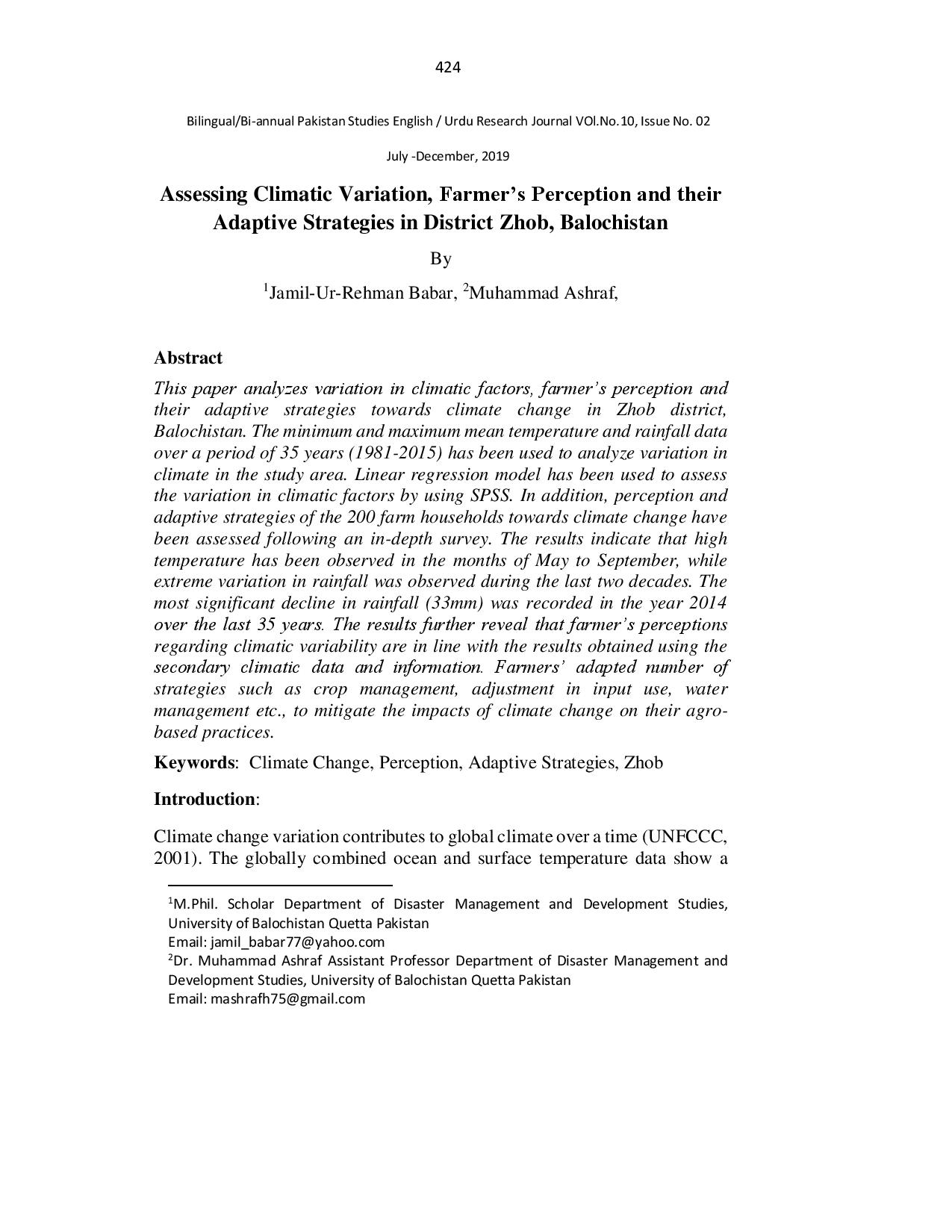Assessing Climatic Variation, Farmer’s Perception and their Adaptive Strategies in District Zhob, Balochistan
Keywords:
Climate Change, Perception, Adaptive Strategies, ZhobAbstract
This paper analyzes variation in climatic factors, farmer’s perception and
their adaptive strategies towards climate change in Zhob district,
Balochistan. The minimum and maximum mean temperature and rainfall data
over a period of 35 years (1981-2015) has been used to analyze variation in
climate in the study area. Linear regression model has been used to assess
the variation in climatic factors by using SPSS. In addition, perception and
adaptive strategies of the 200 farm households towards climate change have
been assessed following an in-depth survey. The results indicate that high
temperature has been observed in the months of May to September, while
extreme variation in rainfall was observed during the last two decades. The
most significant decline in rainfall (33mm) was recorded in the year 2014
over the last 35 years. The results further reveal that farmer’s perceptions
regarding climatic variability are in line with the results obtained using the
secondary climatic data and information. Farmers’ adapted number of
strategies such as crop management, adjustment in input use, water
management etc., to mitigate the impacts of climate change on their agrobased practices.
References
ACCCA. (2010). Advancing Capacity to Support Climate Change
Adoptation. Scientific Research.
Ahmed, M. N., & Schmitz, M. (2011). Economic Assessment of the Impact
of Climate Change on the Agriculture of Pakistan. BEH - Business
and Economic Horizons , 4 (1), 1-12.
Anonymous. (2015). Development Profile of District Zhob. Pakistan Poverty
Alleviation Fund.
Anonymous. (2016). Zhob District Education Plan. Quetta: Educational
Management Information System.
Ayaz, S. u. (2012). Climate Change and Coastal Districts of Balochistan.
Quetta: International union for conservation of nature.
Bari, B. (2013, July 08). Climatic Change and Food Insecurity. p. 1.
Belachew, O., & Zuberi, M. I. (2015). Perception of Climate Change and
Livelihood of a Farming Community of Maruf Kebele, Central
Oromia, Ethiopia. American Journal of Climate Change , 4 (3), 12.
Bhutto, A., & Ming, W. (2013). Impact of El-Nino on Summer Monsoon in
Southern Parts of Pakistan. Pakistan Journal of Meteorology , 10
(19), 8.
C.T.West, C. F. (2008). Local Perceptions and Regional Cimate Trends on
the Central Plateau of Burkina Faso. Land Degradation and
Development , 19 (13), 289-304.
Chaduary et al, Q.-u.-Z. (2009). Climate Change Indecators of Pakistan.
Technical Report, Pakistan meterological Department.
Dube, T., & Phiri, K. (2013). American International Journal of
Contemporary Research , 3 (5), 11-15.
Elagib, N. A., & Addin Abdu, A. S. (1997). Climate Variability and Aridity
in Bahrain. Journal of Arid Environments , 36 (3), 405-419.
Elagiba, N. A., & Abdu, A. S. (1997). Climate Variability and Aridity in
Bahrain. Journal of Arid Environments , 36 (3), 405-419.
Explore Balochiatan. (2016, December 27). Retrieved June 8, 2018, from
Balochistan.Gov.PK:
http://www.balochistan.gov.pk/index.php?option=com_content&vie
w=article&id=37&Itemid=783
Gadiwala, M. S., & Burke, F. (2013). Climate Change and Precipitation in
Pakistan -A Meteorological prospect. International Journal of
Economic and Environmental Geology , 4(2), 6.
IPCC. (2014). Climate Change 2014 Impacts, Adaptation and Vulnerability
Part B Regional Aspects. Intergovernmental Panel on Climate
Change. United States of America: Cambridge University Press.
Kamil, M. (1983). Climate and Meteorology, Syria. 386.
Khyber Organization. (2015, April 1). Retrieved October 11, 2017, from
http://www.khyber.org/places/2005/Zhob_District.shtml
Knowler, D., & Bradshaw, B. (2007). Farmers’ Adoption of Conservation
Agriculture: A Review and Synthesis of Recent Research. Food
Policy , 32 (1), 25-48.
L. B., & Sugulle, A. J. (2011). The Impact of Climate Change and Adoption
of Strategic Coping Mechanism by Agro-pastoralists in Gabiley
Region, Somaliland. Candlelight for Health, Education and
Environment, Hargeisa, Somaliland.
Lehri, A. (2016). Introduction Climate Change and Community Based
Adaptation. Retrieved April 15, 2016, from Lead Pakistan:
http://www.lead.org.pk/lead/pages/projects16.aspx
Mustafa, D., Akhter, M., & Nasrallah, N. (2013). Understanding Pakistan's.
Washington: United States Institute of Peace.
Ole Mertz, C. M. (2010). Climate Factors Play a Limited Role for Past
Adaptation Strategies in West Africa. Ecology and Society , 15 (4).
Ole Mertz, C. M. (2009). Farmers Perceptions of Climate Change and
Agricultural Adaptation Strategies in Rural Sahel. Environmental
Management (43), 804-816.
Parry, A. H. (1986). Precipitation and climatic change in central Sudan In:
Rural Development in the White Nile Province, Sudan. 33-42.
Rafiullah, M. (2015, July 24). District Admin Rush to ZhoB on CM
Directives. p. 1.
Rajendra K. Pachauri, Leo Meyer. (2014). Climate Change 2014 Synthesis
Report. Fifth Assessment Report of the Intergovernmental Panel on
Climate Change , Intergovernmental Panel on Climate Change ,
Geneva, Switzerland.
Trading Economics. (2018). Retrieved June 7, 2018, from Trading
Economics.com:
https://tradingeconomics.com/pakistan/temperature,
https://tradingeconomics.com/pakistan/precipitation
UNESCO. (1977). Map of the World Distribution of Arid Regions. United
Nations Educational Scientific and Cultural Organization, New
York, USA.
UNFCCC. (2001). UNFCCC Status of Ratification. Retrieved May 1, 2017,
from United Nations Framework Convention on Climate Change:
www.unfccc.int
Zhuang. (2009). The Economics of Climate Change in Southeast Asia: A
regional Review. Climate Risk Managment .



